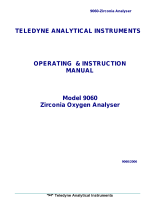
October 2016
TN05 520-1004 Rev 3
Technical note
MTL gas analysers & systems
Eaton Electric Limited,
Great Marlings, Butterfield, Luton
Beds, LU2 8DL, UK.
Tel: + 44 (0)1582 723633 Fax: + 44 (0)1582 422283
www.mtl-inst.com
© 2016 Eaton
All Rights Reserved
Publication No. TN05 520-1004 Rev 3
October 2016
Oxygen Potential Measurements
in Metal Heat Treatment Processes
For any particular metal or other oxidisable element a value
of oxygen potential called the "free energy of formation" of
the oxide exists. Above this value the metal will be oxidised
but below no oxidation will take place.
This value is very much dependent upon temperature and usually
increases with increasing temperature. The diagram on this
page illustrates this for several elements. Nickel, for example,
will undergo oxidation to nickel oxide (NiO) in an atmosphere
with an oxygen potential greater than -60 kilocalories/mole at
1000°C, or -81 kilocalories/mole at 500°C. Chromium has a
greater affinity for oxygen than nickel as shown by its lower
line on the diagram. It would require an oxygen potential of less
than -130 kilocalories/mole at 1000°C to prevent oxidation. Thus
an atmosphere which is just adequate to prevent nickel from
oxidising would not protect chromium from oxidation. Note that
the lines on the diagram are for the lowest oxidation state of
element.
Diagrams such as this enable the theoretical level of oxygen
potential to be determined for a variety of conditions. For example
if steel is to be decarburised by oxidising some of the carbon
in the metal, and yet simultaneous oxidation of the metal is to
be prevented, then at 1000°C this could be done at an oxygen
potential of -100 kilocalories/mole. Below about 750°C however,
it will not be possible to decarburise without simultaneously
oxidising the iron in the steel, since the carbon line crosses the
iron line on the free energy diagram at this temperature.
In the past the measurement of the oxidising/reducing power
of a protective atmosphere, or the carbon potential of a
carburising atmosphere, was achieved inferentially; either by the
measurement of the CO2 content, the CO/CO2 ratio or the dew
point (effectively the moisture content), depending upon the
nature of the atmosphere. These measurements can however
be directly related to the oxygen potential or the oxygen partial
pressure. For example a rich exothermic gas having a CO/CO2
ratio of 10 has an oxygen potential of -93 kilocalories/mole or
an oxygen partial pressure of 10-16 atmospheres at 1000°C.
Similarly a lean exothermic gas with a CO/CO2 ratio of 0.1 has
an oxygen potential of -70 kilocalories/mole or an oxygen partial
pressure of 10-12 atmospheres at 1000°C. Cracked ammonia,
which is frequently used when bright annealing stainless steel,
is usually monitored by dew point measurement. This is related
to the water content in the gas from which the H2/H2O ratio
can be calculated - assuming that the H2 content is known and
constant - which is in turn related to the oxygen potential.
This data only provides information on whether or not a particular
metal etc. will oxidise or not under certain conditions; it says
nothing about factors such as rate of oxidation etc. Factors such
as these will sometimes mean that higher oxygen potentials
can be permitted than theoretical considerations alone would
indicate. Furthermore, a certain amount of surface oxidation of
the metal may be quite acceptable. Factors such as these should
be taken into account when determining the most economic
way to operate a process.
A zirconia oxygen sensor/analyser can provide very valuable
information for analysing the effect of various conditions, as
well as for controlling at the optimum condition once this has
been established.
Atmospheres
Exothermic atmospheres are produced by burning a gaseous
fuel, typically natural gas or methane, in varying amounts of air.
These atmospheres can vary widely in composition depending
on the air/gas ratio. They are frequently referred to as either
rich or lean. Rich atmospheres contain excess ‘fuel’ which can
sometimes mean they are flammable themselves, whereas
lean atmospheres do not. The atmosphere is used to protect
metals from oxidation during heat treatment processes such
as annealing. Rich atmospheres tend to be used for ferrous
metals, which require a lower oxygen content than non-ferrous
(copper bearing) metals, which tend to use lean atmospheres to
protect them.




